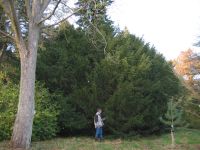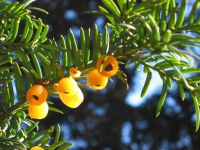Common Yew - Taxus baccata
English name:
Common Yew
Scientific name:
Taxus baccata
Family:
Taxaceae (yew)
Height:
up to 16 M in Denmark
Flowering:
March
Range:
Europe, North Africa, Western Asia
 |
|
 |
 |
The 48 year old group of Taxus baccata in the main picture comes from Munkebjerg Strandskov near Vejle on the Jutland peninsula. This place is thought to be the only remaining natural occurrence of this species in Denmark. Our specimens are found by our collection of European conifers: square 1507 position 3218.
Plant description:
The yew or Taxus baccata is a remarkable plant once one begins to understand its importance in history. Many ancient myths are associated with this plant and holy yew trees occur across Europe. Its wood and bark has helped man survive and flourish through the millennia. The oldest wooden tool ever found is reported to be a yew spear more than 250,000 years old. Recently yew has achieved fame as a source of the important anti-cancer drug, Taxol. But yew has probably been best known for making bows.
The genus Taxus is widely distributed in the Northern hemisphere and even extends south of the equator in Malaysia. About 10 different species of yew are recognised. However, they are very similar in many respects and more research is needed in defining the different species. All are evergreen, needle-leaved trees or bushes. The poisonous seed is subtended by a fleshly coat (aril) which is normally red when ripe and the only part of the plant that is not poisonous. Since the seed is poisonous caution is strongly advised. Yew is not just poisonous to man but is strongly poisonous to cattle and especially horses.
We have 5 species of Taxus growing in the Hørsholm Arboretum and there are 57 specimens of Taxus baccata. Most are of garden origin, like for example the yellow fruited cultivar Lutea in one of the pictures. This cultivar was found near Dublin Ireland in 1817. Wild collected specimens come from Denmark, France, Norway, and Poland.
Yew re-invaded Denmark about 7000 to 8000 years ago following the last ice age and although only reported to be naturally occurring at one place, it was once much more common. An old Nordic name for yew, Yr, is also reported to be adapted to Y or I and added to many place names in Denmark like Ibæk, Idum, Ikast, Inæs, Irup, Isted, and Yding.
Like in the rest of Europe, many ancient stands have been exterminated or reduced to a few remnants. Now the yew is seen across the country as garden escapes.
Taxus baccata, an evergreen conifer, forms a large bush or small tree up to about 16 m tall in Denmark. The flaky bark is red-brown or purplish, often fluted, and thin. Twigs are green for about 2 years. The ovoid green buds are about 2-3 mm. The leaves are flat with a raised rib on the dark-green upper side and have a green petiole and are light green underneath. Normally they are arranged in one plain on shaded shoots but form a V-shape on more exposed branches. However, strong variations in leaf size, shape and colour can be seen on the many cultivars that exist. Male and female flowers normally occur on different plants but occasionally plants are bisexual. The male flowers send out a shower of pollen when shaken in March.
This species is very shade tolerant and can even survive under a beech forest. It is also strongly tolerant of air pollution and tolerates pruning. Once established it is quite tolerant of drought. Yews may live to be more than 1000 years old, but secure ages can not be given because the oldest trees are hollow inside so one can not count the growth rings. The well-known Bromølle yew in Denmark was measured to be 12.4 m tall in 1991 and 113 cm in diameter and is probably about 200 years old.
References:
Farjon, A. 2001. World Checklist and Bibliography of Conifers. Royal Botanic Gardens, Kew. 309 pp.
Lange, J. 1968. Bromølletaksens alder (Bromølle yews age). Dansk Dendrologisk Forenings Årsskrift 3(1): 73-79.
Lewington, A. & Parker, E. 1999. Ancient Trees. Trees that live for a thousand years. Collins & Brown Ltd. London. 192 pp.
Møller, P.F. & Staun, H. 2001. Danmarks Træer og buske. Politikens Forlag A/S, Copenhagen, 336 pp.
Ouden, P. den, Boom, B.K. 1965. Manual of Cultivated Conifers. Martinus Nijhoff, The Hague. 520 pp.
Rushforth, K. 1999. Trees of Britain & Europe. Harper Collins Publishers. 1336 pp.
